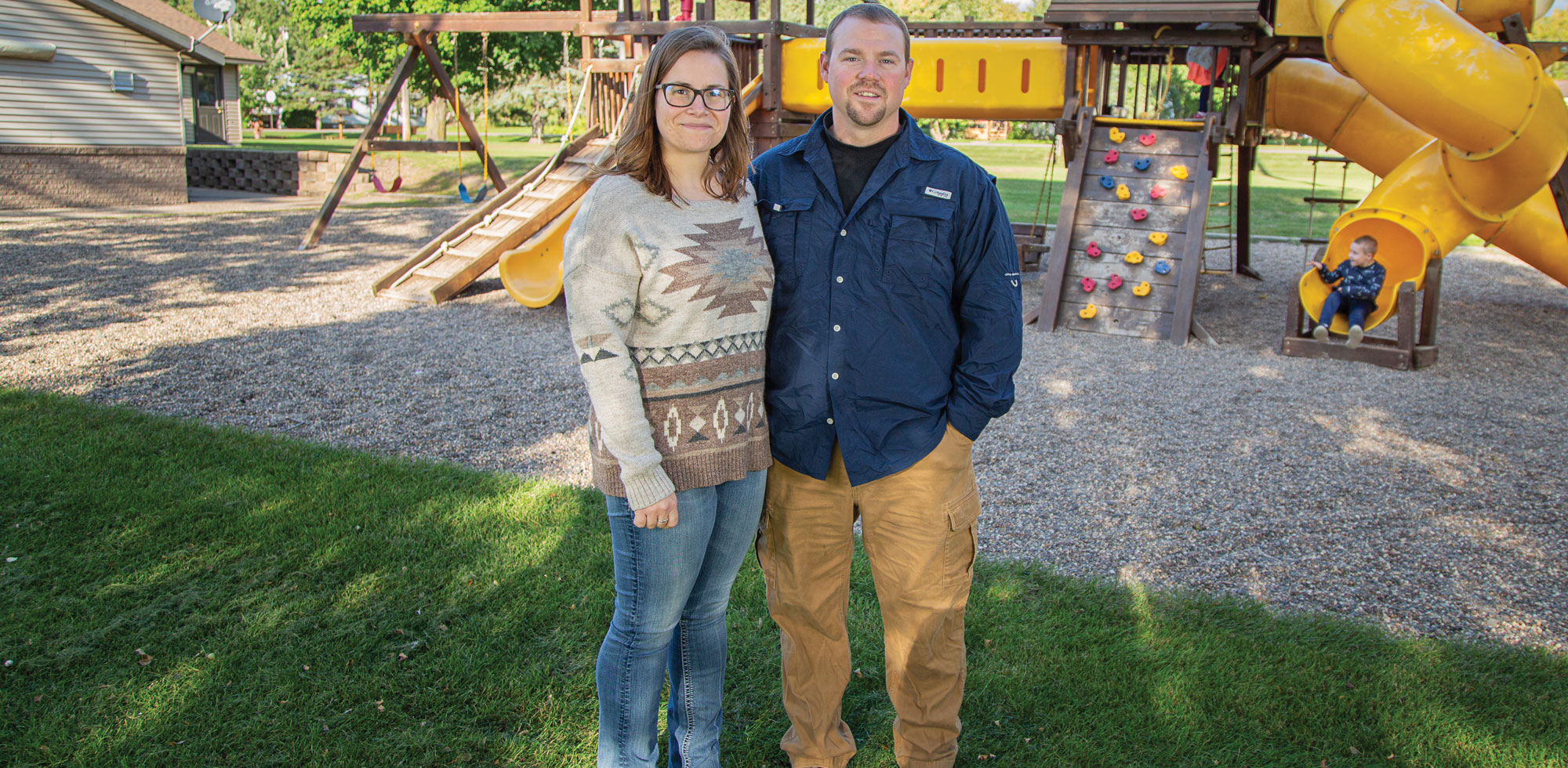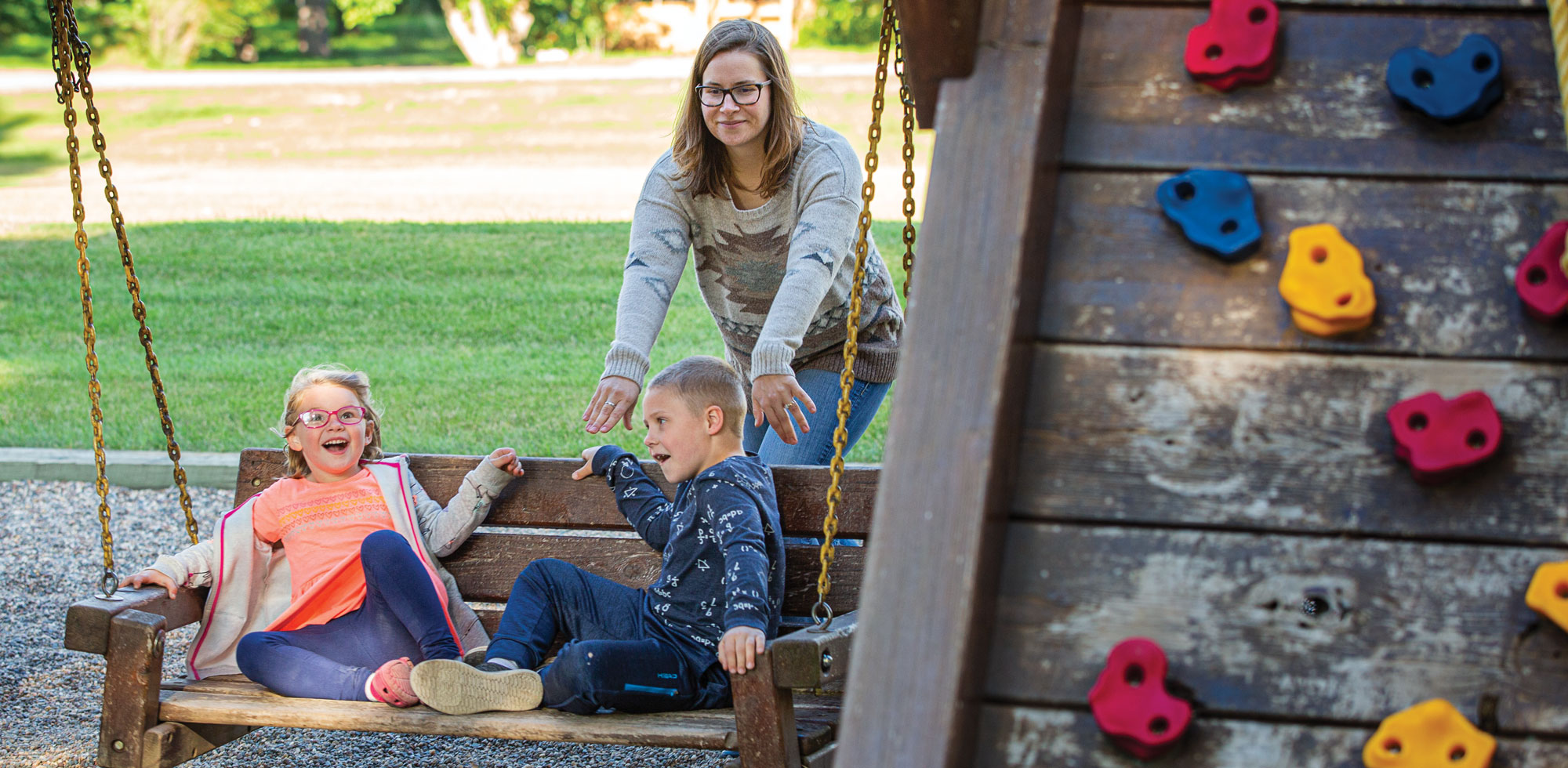
Crisis in Caring
When COVID-19 threatened the childcare sector, the Initiative Foundation created an emergency grant program to help.
By Andy Steiner | Photography by John Linn and Michael Schoenecker
Fifteen years ago, when Jennifer Chilton opened Jenny’s Daycare, her home-based child care center in Finlayson, she never thought that her thriving Pine County business would be threatened by a global pandemic. But that’s what happened following Minnesota Gov. Tim Walz’s stay-at-home order to flatten the curve of COVID-19 infection.
“A lot of my parents got laid off or furloughed at work,” Chilton explained. “When they’re not working they’re not bringing their kids to me. So I lost a lot of my kids pretty quickly.”
Chilton couldn’t expect out-of-work parents to pay for daycare, but the losses hurt her bottom line: “Those parents felt bad. And I couldn’t make them pay for their spots when they didn’t have work.” At the same time, essential workers relied on Chilton’s center to stay open so they could work at their jobs in nursing homes, at the local hospital and the Minnesota Correctional Facility in nearby Moose Lake. Chilton felt like she was being pulled in two directions. “But we are all in this together— we are all losing money. And other families really needed me to stay open.”
The personal toll was undeniable. Revenue from the center makes up a significant portion of the Chilton family’s annual income. With fewer kids to care for, “we were struggling,” she said. “We had to call the bank and say we couldn’t make some payments.” Because she’s self-employed, Chilton wasn’t eligible for unemployment. “Daycare providers don’t get unemployment,” she said with a sigh. “So we didn’t have that extra $600 a week from the government.”
The situation was growing more dire by the day when another provider told Chilton about a special Initiative Foundation grant program to help regional child care providers weather the COVID storm until Child Care Aware, a statewide agency, could distribute some $30 million in child care support funds authorized by the Minnesota Legislature.
Chilton quickly filled out an application and was awarded a one-time grant of $1,000. The money, which came in a matter of days, was just what she and her family needed to make ends meet and keep her daycare in business. The Initiative Foundation grant—one of 111 disbursed to home-and center-based providers throughout Central Minnesota—was used to cover bills and expenses, including filling her home’s propane tank.
“The Initiative Foundation grant was amazing,” Chilton recalls. “Any amount of money helped.”
IMMEDIATE RESPONSE
The philanthropic world doesn’t always turn on a dime, but the six Minnesota Initiative Foundations rolled out their child care provider grant program in a matter of days after Gov. Walz asked them to carve out some of their own grant money to serve as a lifeline until the Minnesota Legislature could approve a more robust funding package for child care grants. “It was the first weeks of the pandemic where many providers were suffering the effects of the emergency stay-at-home orders and many households were keeping their kids at home,” said Don Hickman, Initiative Foundation vice president for community and workforce development. “Whether due to business shutdowns, job losses or remote work, COVID-19 really created a tremendous disruption. The profit margins in child care are razor thin, and our region—which already is in acute child care shortage—can’t afford to lose any providers.”
The Initiative Foundation program was designed to parcel out small grants from a fund of $153,500. Word was quickly sent out to local providers, and the response was immediate and overwhelming.
“In a matter of days, we had more than $2 million in requests from 800 providers, both home daycares and centers,” Hickman said. “The max they could request was $3,000. It was painful to decide who got the first grants.”
Initiative Foundation staff used a set criteria to determine how grants were awarded. Because the program was designed to provide COVID relief, “The primary factor was the number of children of essential workers that the provider was caring for paired with geographic diversity. We felt the need to spread it over all the 14 counties that we serve in Central Minnesota.”
Clare Sanford, government relations chair for the Minnesota Child Care Association, was impressed with how quickly the Minnesota Initiative Foundations responded to the industry crisis.
“The [Central Minnesota] Initiative Foundation was out in front even of the state of Minnesota,” she said. “They recognized right away what this pandemic would do to our already in-crisis child care system. This money came together super quickly. They got applications out super quickly. And they spent the money super quickly.”
The extra money was essential. “There’s no doubt that every business in the state is going through a tough time, but not every business has been asked by the governor to stay open to support the emergency response,” said Sanford.

For many of the region’s essential workers, the child care grants saved the day. Stephanie Silgjord of Grey Eagle is a social worker who provides therapy to young survivors of sexual violence in the Todd County region. Her husband Caleb works in law enforcement. The couple relies on their home-based provider, Blue Goose Development, to care for their two young children so they can keep showing up for their jobs.
Both of Silgjord’s children—a first-grader and a preschooler—were enrolled in part-time child care when the pandemic hit; when the governor shifted the state’s schools to distance learning, her provider requested and was awarded an emergency grant from the Initiative Foundation.
“When distance learning happened in April, we were given the responsibility to educate our children,” Silgjord recalled. “With both of us working split shifts and full-time, I don’t know how long we would’ve been able to make it work.”
Thanks to the grant money, Silgjord’s provider was able to hire an assistant. “They were able to sit down with our kids based on age level and help them do their homework assignments,” Silgjord said. Going to work and caring for kids during a pandemic was something Silgjord and her husband couldn’t do alone. “Without that extra help at daycare, I don’t know how we would’ve done it.”
Stephanie Hoehle, a single mother of three from Little Falls, is also an essential worker. When COVID-19 hit Minnesota, her child care center closed for two weeks. She had to scramble to find temporary care so she could continue her work installing fiber optic lines for military and space systems.
An Initiative Foundation grant made it possible for Hoehle’s center—Big Adventures Child Care Center in Little Falls—to re-open, even though some parents had decided to keep their children at home. An additional Child Care Aware grant has helped to keep the center running since then.
“If they hadn’t opened back up, I don’t know what I would’ve done,” Hoehle said. “The grant made it possible for my provider to stay open, for my kids to get back to the center and for me to get back to work. It was a real lifesaver all the way around.”
A PRE-EXISTING CONDITION
The region already was experiencing a child care crisis before the COVID-19 pandemic emerged. Pre-pandemic, “our region had a greater gap in the number of child care slots needed than are available,” said Hickman. In fact, a Center for Rural Policy study found that Central Minnesota had 29,253 child care slots but needed 43,551 to meet regional demand. “We were leading Greater Minnesota in job creation but we didn’t have enough child care. Those are two trends headed in the opposite directions. You can’t attract more workers and have fewer child care options.”
The turmoil created by the virus made the region’s child care shortage even more pronounced and clarified the urgent need to redesign the existing system once the pandemic passes.
“A lot of wise people are saying we don’t want to go back to ‘normal’ because that wasn’t working for many families and child care providers in the first place,” Hickman said. “Parents struggle to afford it, yet providers are making very little profit. Serious change needs to happen.”
Though the crisis illustrated that the region’s child care system was lacking, it also highlighted the central role that providers play in keeping the economy rolling in good times and bad. “There has never been a time that was more clear that you can’t keep the economy going without child care,” Hickman said.
In recognition of the central role that child care providers play in the state’s economy, the Minnesota Department of Education in August supported the Initiative Foundation with an additional $416,000 to be awarded to the early childhood sector.
“The grants are designed to fund a range of activities, from distance learning and summer programs to programs that support the mental health of child care providers, training on how to talk to kids about the pandemic, and basic supplies to clean and sterilize childcare facilities,” Hickman said. The Foundation awarded $140,000 in August. A second round of funding will take place at the end of 2020 and a third round early in the spring of 2021.
Chilton says she’s pleased to hear that more support will soon be available. Though parents are slowly bringing their children back to Jenny’s Daycare, it will be a while before she gets back to pre-pandemic enrollment levels.
“I’m filling back up,” she said. “But there still are days where I’ll have just five or six kids. Some days I’ll have more. It’s still not normal. So any support is welcome. I don’t want to close—and I don’t want to leave my families with nowhere to turn.”
